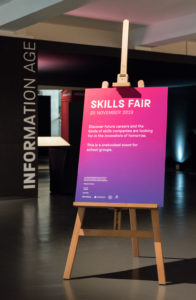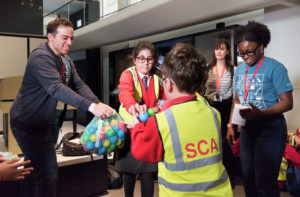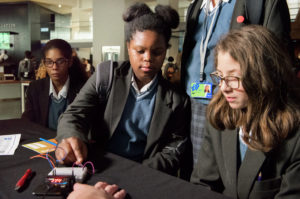 Many of the science, technology, engineering and maths (STEM) jobs that a 10-year old will be doing in their future don’t even exist today.
Many of the science, technology, engineering and maths (STEM) jobs that a 10-year old will be doing in their future don’t even exist today.
Our Skills Fair was an opportunity for students to discover future careers and the kinds of skills companies are looking for in the innovators of tomorrow.
With over 300 students attending our fair, we wanted to highlight and help them recognise that they already have, and use, many of the important skills that are needed in STEM-related jobs.
Students had the opportunity to meet a variety of people who do science-related jobs, from a mix of employers and universities running hands-on activities.
We wanted the employers to focus on the skills that are needed in their roles, and ran training sessions with the Science Museum Group Academy for them prior to the event; getting each organisation to come up with the three most important skills in their industry.
Initially, the employers discussed quite detailed and specific skills, such as computer programming or data analysis. We worked with them to think about how we could break these skills down further into ones that were relatable and recognisable to students.
Interestingly, all groups independently came up with the same three skills: problem solving, creativity and teamwork. This led to one of the main learning objectives for the event: helping students to recognise that they have, and use, these skills, and that these are the skills that are useful for working in roles that relate to STEM.
What sorts of activities did the groups come up with to highlight these skills?

One of the groups designed a game in which teams of students had to pass a ball around in order to reach a target. The group emphasised that the teamwork and creativity skills required to complete the game were comparative to those needed to solve concurrency problems in software engineering; problems that arise when you’re trying to make multiple changes to data sets simultaneously.
 Another group gave teams of students a half-completed BBC micro:bit code and got them to work together and creatively problem solve in order to write the rest of the code. The teams wrote code, tested it, made changes, tested it again, modifying the code multiple times until the desired outcome was reached. This way of working mimics a process called Test Driven Development that real software engineers use in order to develop higher quality software.
Another group gave teams of students a half-completed BBC micro:bit code and got them to work together and creatively problem solve in order to write the rest of the code. The teams wrote code, tested it, made changes, tested it again, modifying the code multiple times until the desired outcome was reached. This way of working mimics a process called Test Driven Development that real software engineers use in order to develop higher quality software.
During the activities, it was great to see employers relating the three skills to their work, and helping the students see how these skills, that they use in their everyday lives, can help them in future careers.
It was really exciting to see the students discussing how each of the groups used the skills, and where they have been gaining and using them in their own lives. The feedback we received from the students in response to the question, ‘What do you think the Skills Fair was trying to tell you?’ really emphasised that they went away feeling that they possess skills for STEM-related roles and that STEM is something that they can relate to. For example:
‘That different jobs require different skills which we all possess’
‘Learning that there is more to science than labs and doctors. There is whole world of science that we didn’t know about’
We were really encouraged by the skills fair and its potential to make STEM roles feel more relatable to students. Following the success of this event, we will be running another skills fair this year, working with a new range of employers and universities – this time related to Medicine. It will be interesting to discover the top three skills they use in their roles.
The Science Museum Skills Fair was made possible thanks to support from STEM Circle partners including: Cisco (Premier Partner), BT, Bloomberg, MathWorks and Sanofi. The STEM Circle is the Science Museum’s corporate membership programme and brings together a community of organisations that are committed to engaging the next generation with the skills of the future.
This is a very positive step in creating awareness,team work to look out for solutions collectively for problems and solving the problems before they even arise.It makes the world a better place.